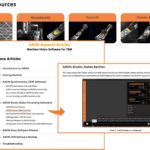
In a world where 3D printing and nanotechnology are becoming commonplace, Dr. Ray Unocic has discovered a way to do both simultaneously.
Nanoscale 3D Printing Within a Liquid Cell
In a recent paper in Nanoscale, Dr. Unocic and colleagues from Oak Ridge National Lab outline a technique and preliminary results for a completely new type of material printing process. Using an aberration-corrected Scanning Transmission Electron Microscope (STEM), fitted with a Protochips Poseidon Select liquid cell, they were able to turn the electron beam into a sub angstrom, palladium-writing nanoparticle generator. This was possible by filling the liquid cell with an H2PdCl4 solution that reduces under the electron beam to form Pd nanoparticles in a process called “radiolysis”. By adjusting the electron beam position, dwell time and spot size, Dr. Unocic was able to draw shapes, letters, and even entire words into the liquid cell. With the electron beam being smaller than a single atom, this technique could allow scientists to 3D print objects on an unprecedented tiny scale.
What’s Next: True Nanoscale Printing in Liquid Cells
Although the paper only outlines the printing of a single layer of Pd nanoparticles, Dr. Unocic is already working on making more complex objects. He plans to do this by using different liquids to deposit different metals – an easy task with the interchangeable liquid system within Protochips’ Poseidon Select. Once automated, this atomic resolution layering process of different materials could allow for a more scalable 3D printing technique on a truly nanoscale level. Scientists in other fields are already working on applications for “nanomotors” and “mechanical machines”, which will be used for drug delivery, artificial muscles, and nanolenses.
This type of direct-writing is a new application that has sprung out of the diverse capabilities of the Poseidon Select system, which Dr. Unocic and colleagues have been using since 2012. Their previous work demonstrated precise electrical control and real time electrolyte monitoring of nanoscale liquid batteries within the TEM.
From batteries to 3D printing, Dr. Unocic tackles big problems using in situ microscopy to study the smallest things.
Learn more about the varied research capabilities of the Poseidon Select liquid cell technology.










